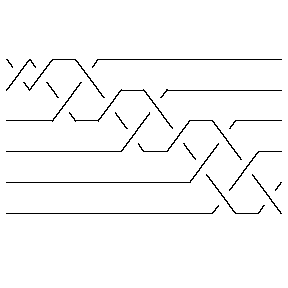Next: 5 Graphical Output Up: 4 Presentations Previous: 4.3 DT (Dowker-Thistlethwaite) Codes Contents Index
![]()
![]()
![]()
![]()
![]()
Next: 5 Graphical Output
Up: 4 Presentations
Previous: 4.3 DT (Dowker-Thistlethwaite) Codes
Contents
Index
Every knot and every link is the closure of a braid. KnotTheory` can also represent knots and links as braid closures:
|
In[2]:= ?BR
In[3]:= BR::about
In[4]:= ?Mirror
|
Thus for example,
In[5]:= | br1 = BR[2, {-1, -1, -1}]; |
In[6]:= | PD[br1, q] |
Out[6]= | PD[BR[2, {-1, -1, -1}], q] |
In[7]:= | Jones[br1][q] |
Out[7]= | -4 -3 1
-q + q + -
q |
In[8]:= | Mirror[br1] |
Out[8]= | BR[2, {1, 1, 1}] |
KnotTheory` has the braid representatives of some knots and links pre-loaded. Thus for example,
In[9]:= | BR[TorusKnot[5, 4]] |
Out[9]= | BR[4, {1, 2, 3, 1, 2, 3, 1, 2, 3, 1, 2, 3, 1, 2, 3}] |
The minimum braid representative of a given knot is a braid
representative for that knot which has a minimal number of braid
crossings and within those braid representatives with a minimal number
of braid crossings, it has a minimal number of strands (full details
are in Gittings' [Gi]). Thomas Gittings kindly
provided us the minimum braid representatives for all knots with up to 10
crossings. Thus for example, the minimum braid representative for the knot
![]() has length (number of crossings)
13 and width (number of strands, also see
Section 7.1) 6:
has length (number of crossings)
13 and width (number of strands, also see
Section 7.1) 6:
In[10]:= | br2 = BR[Knot[10, 1]] |
Out[10]= | BR[6, {-1, -1, -2, 1, -2, -3, 2, -3, -4, 3, 5, -4, 5}] |
In[11]:= | Show[BraidPlot[CollapseBraid[br2]]] |
 | |
Out[11]= | -Graphics- |
(Check Section 5.2 for information about the command BraidPlot and the related command CollapseBraid.)